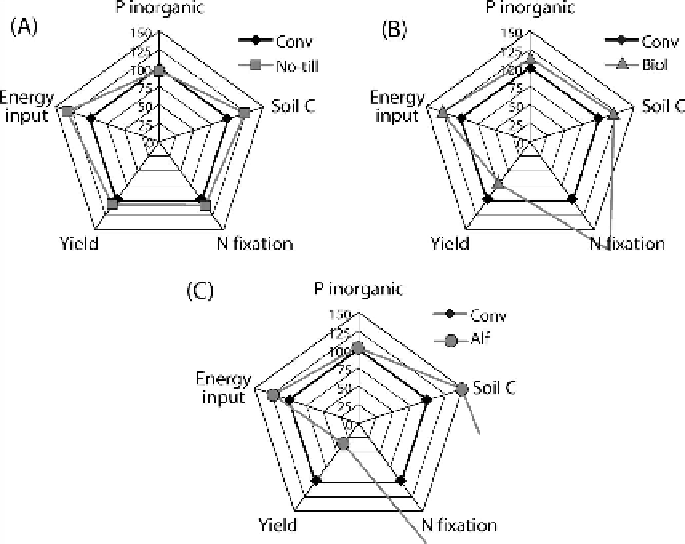Agriculture Reference
In-Depth Information
as key processes supporting gains in yield stability under organic management
(El-Hage Scialabba and Müller-Lindenlauf 2010). However, MCSE data provide
no evidence that Reduced Input and Biologically Based systems resulted in greater
cropping system resistance to changing weather patterns.
Soil Carbon
Over the first 10 years of the MCSE, the No-till system rapidly accumulated soil C
relative to the Conventional system; by 2001 soil C was 8.5 kg m
−2
to a 1-m depth.
This was 23% higher than in the Conventional system, which held 6.9 kg C m
−2
(Fig. 15.1A). Surprisingly, over the same time period, a 20% increase of soil C in
the Biologically Based system also occurred, even though this system relies on fre-
quent soil disturbance to manage weeds (Fig. 15.1B). This suggests that the soil C
that accumulates under biological management is physically stable and persistent.
In contrast, soil C accumulation under no-till management is evidently vulnerable
Figure 15.1
. Ecosystem services from the KBS LTER Main Cropping System Experiment
(MCSE). Results are presented as percent change relative to the Conventional (Conv) system
in radial graphs for (A) No-till, (B) Biologically Based (Biol), and (C) Alfalfa (Alf). Values
for the Conventional system used as 100%: soil inorganic phosphorus 30 mg P kg
-1
; soil C
3.2 kg m
-1
; biological N fixation 27 kg N ha
-1
yr
-1
; grain yield 3.92 Mg ha
-1
, with alfalfa for-
age biomass valued at 1/5th grain; and energy inputs 7.1 GJ ha
-1
yr
-1
. Note that biological N
fixation for alfalfa extends beyond the range of the figure.

